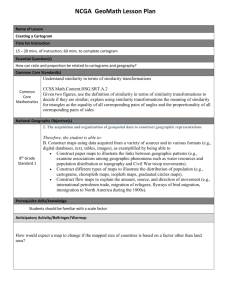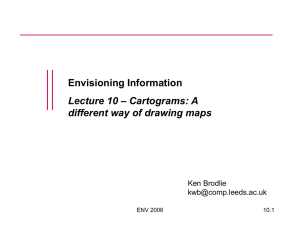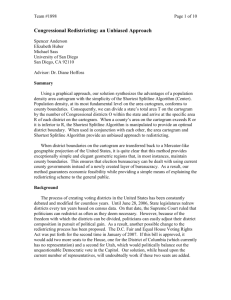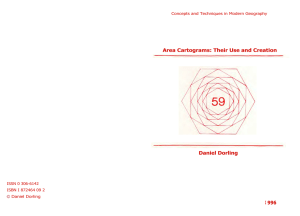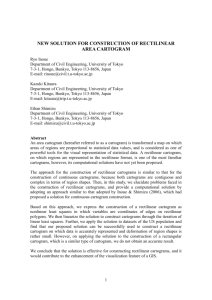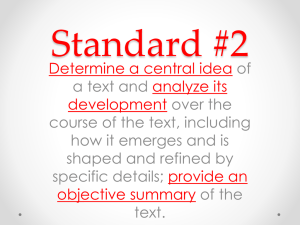cartogram - Mounds View School Websites
advertisement
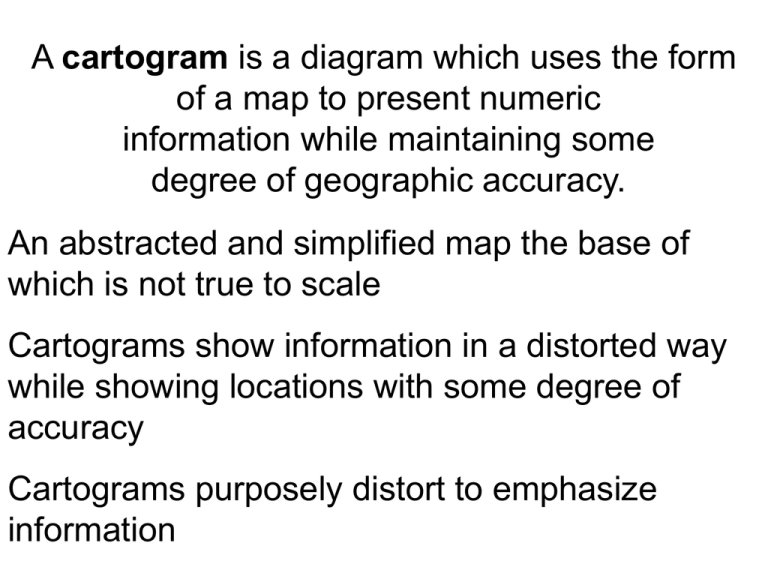
A cartogram is a diagram which uses the form of a map to present numeric information while maintaining some degree of geographic accuracy. An abstracted and simplified map the base of which is not true to scale Cartograms show information in a distorted way while showing locations with some degree of accuracy Cartograms purposely distort to emphasize information For example, the above figure is a Cartogram of World Population -notice countries are in accurate relative locations compared to other countries -color used here to simply distinguish continental areas, however, color schemes may be used to differentiate data This cartogram is “Gross Domestic Product per Country” -largest countries have highest GDP This is a cartogram showing Toy Exports per Country (Asia—largest toy exporting area) Where do you think the most toys are imported? Toys Imported per Country Was this what you thought? Underweight Children per Country -many variables may be mapped into a cartogram Overcrowded Homes For this activity, you are going to create a cartogram of U.S. population You will create the cartogram on graph paper, in which each square of the graph will represent a unit of what is being displayed For this activity, you will receive: •Chart showing U.S. population by state •Blank sheet of graph paper Your task is to create a cartogram with the data from the population chart 1st: Choose a scale for your map •I suggest that one square on the graph paper equals 500,000 people (1/2 million per square) •Or, you may use 1 square = 1 million 2nd: Use pencil to create your cartogram. Try to give states as true of shape and relative location to other states as you can. 3rd: You will color each state using a choroplethic map-coloring system (see next slide) 3rd: (continued) -You will need to use 5 colors on your map. You should pick out colors that go from a lighter to a darker shade. You need to show this scale in a legend found somewhere on your cartogram. The lightest color will represent states with lesser populations. Use the following categories for your coloring: •States with 3 million or less residents •States with 3 million to 5 million residents •States with 5 million to 10 million residents •States with 10 million to 20 million residents •States with over 20 million residents 4th: Title your map “U.S. Population by State, 2000” Source is U.S. Census Data (this should be displayed somewhere on your cartogram as well Points for this cartogram: Title: 1 point Legend: 1 points Source: 1 point Choroplethic color scheme: 3 points Accuracy of cartogram: 6 points Accuracy of relative locations of states: 6 points Neatness: 6 points Summary paragraph: 6 points TOTAL POINTS POSSIBLE: 30 SUMMARY PARAGRAPH: once you have completed your cartogram, write a summary paragraph in which you make at least three relevant inferences from your cartogram. These inferences should address, “what can I learn from looking at this cartogram?” You should make an inference, then write at least one supporting statement for each inference using information from the cartogram. For instance, “states with higher populations tend to be toward the fringes, while states with lower populations are found in the interior regions of the United States.” This related to our previous discussions in which I pointed out “4 out of 5 humans live within 500 miles of an ocean.” So, observe the map and make inferences. Things you can look at include: •Is there relationship between largest states and largest populations? •Is there an area of the U.S. that seems to have a number of darker shaded states? Why would this be? •Why are some of the largest states lightest in color? •Come up with your own, too!!
